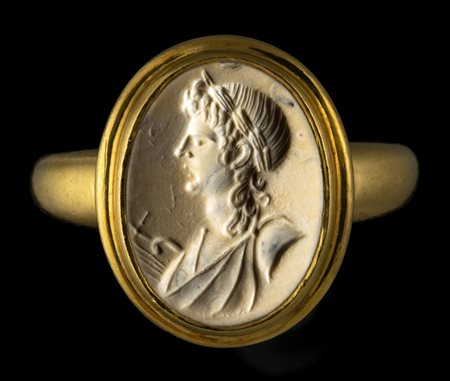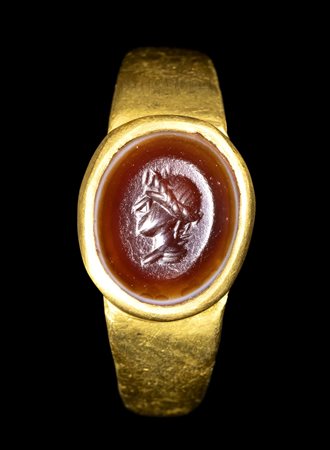ASTA 267 - GLITTICA
-

Lotto 169 A LARGE ROMAN BURNT CARNELIAN SET IN A MODERN SOLID GOLD RING. BUST OF APOLLO.
1st century B.C.
Stone 13,5x18,5 mm; int. Size 18x22 mm; 19,35
The god is facing left, his hair adorned by a laurel wreath. He wears a draped tunic attached on the shoulders. Behind, his lyra. Presence of globular elements. Wear marks.
Provenance: From a private collection, France, acquired from Christie's sale 17/02/2011 (Collection Jean-Philippe Mariaud de Serres). -

Lotto 170 A ROMAN GOLD RING SET WITH A CARNELIAN INTAGLIO. BUST OF A YOUTH.
2nd - 3rd century A.D.
Stone 8x10 mm; int. size 17x18 mm; 4,00 gr
With large flatten hoop expanding directly onto an oval bezel set with a carnelian intaglio; portrait of a youth facing left, wearing a laurel wreath. Wear marks.
Provenance: U.K. private collection -

Lotto 171 A ROMAN CARNELIAN INTAGLIO SET IN A GOLD RING. BUST OF ATTIS.
1st century A.D.
Stone 11x15 mm; int. diam 17 mm; 6,76 gr
The young man is turned to the left, wearing his typical Phrygian cap (from which the long hair comes out) and a long sleeved, heavy, hatched "sweater". He is holding the pedum in his left hand; in his right hand, between two fingers, he is holding a small fruit (which can be identified with an almond), which he carefully observes. According to the myth, a plant, in the form of an almond tree, was born from the blood spilling from his father's (Adgistis) castration (Pausania); Nana, daughter to the king Sangarius, picked an almond and got pregnant, giving birth to Attis. Following the myth, in this intaglio Attis is contemplating the fruit which was the cause of his divine conception. Extraordinary iconography, and of a particular interest, also related to the cult of Cybele and to mysteries, with an allegorical reference to fecundation. The stone is chipped in its upper part, and fragmented at the bottom, partially reintegrated by the gold of the modern mounting.
Provenance: U.K. private collection -

Lotto 172 A ROMAN GOLD RING SET WITH A CARNELIAN INTAGLIO. BUST OF A GODDESS.
2nd century A.D.
Stone 11x13 mm; 9,90 gr; int. size 19,5x20,5 mm
With rounded hoop, the shoulders agremented with two gold spherical beads surmounting a layered bezel set with a carnelian intaglio depicting a laureated divinity facing left; probably Apollo. Surface of the mounting has been retooled. Wear marks.
Provenance: U.K. private collection -

Lotto 173 A ROMAN CARNELIAN INTAGLIO. PORTRAIT OF ARTEMIS.
1st century A.D.
13x15x3 mm
The goddess is facing left with quiver and bow behind her shoulder. Wear marks.
Provenance: U.K. private collection -

Lotto 174 A ROMAN CARNELIAN INTAGLIO. BUST OF ARTEMIS.
2nd century A.D.
10 x 11 x 2 mm
The goddess is facing left, the head adorned with a diadema. Behind her shoulder a bow. Wear marks.
Provenance: From the collection of an European gentleman, acquired on the art market -

Lotto 175 A LARGE ROMAN HOLLOW GOLD RING SET WITH AN AGATE INTAGLIO. BUST OF ATHENA.
1st century B.C. - 1st century A.D.
Stone 12x16 mm; int. size 16x18 mm; 10.68 gr
With large rounded hollowed hoop ending onto an oval bezel set with an agate intaglio. Bust of helmeted Athena facing left. She wears the armour with the snake. Use of globular elements. Wear marks.
Provenance: U.K. private collection -

Lotto 176 A LATE ROMAN AGATE CAMEO SET IN A GOLD RING. HELMETED BUST.
3rd - 4th century A.D.
Stone 13x19 mm; int. Size 18,5x19 mm; 16,33 gr
The effigy, turned to the right, is wearing the chlamys, showing a naked shoulder. The stone has been vigorously engraved in high relief, with a clear detachment of the figure from the field. Probably Athena, or a soldier. Some chippings and small lacks. Wear marks.
See: Martin Henig, The Content Cameos, p. 76 n.137.
Provenance: European collection, acquired on the market, early 2000's. -

Lotto 177 AN EASTERN ROMAN GOLD RING SET WITH A JASPER INTAGLIO. DOUBLE PORTRAIT OF HELIOS AND SELENE.
2nd - 3rd century A.D.
Stone 10x14 mm; 4,81 gr; int. size 17x25 mm
With rounded hoop, flatten within, the shoulder with leaves pattern surmounting an oval gold box setting with a jasper intaglio depicting Helios and Selene. The double portrait is facing left. Wear marks.
Provenance: U.K. private collection -

Lotto 178 A ROMAN GREEN CHALCEDONY INTAGLIO SET IN A MODERN GOLD RING. TWO PORTRAITS.
2nd-3rd century A.D.
Stone 12,5x15 mm; int. Size 18x19 mm; 8,78 gr.
Two facing portraits, probably of spouses. To the left, a diademed and draped female bust. To the right, draped male bust. Beautiful variety of vivid green chalcedony characterized by a very convex profile. Missing on the edge. Wear marks.
Provenance: U.K. private collection -

Lotto 179 A LARGE ROMAN TWO LAYERED AGATE INTAGLIO. DOUBLE BUST PORTRAIT.
2nd - 3rd century A.D.
12x19x4 mm
To the left side a draped male bust, to the right the bust of Helios. The two characters look at each other. On the sides of each one, a stylized torch. Slight wear marks.
Provenance: U.K private collection -

Lotto 180 A ROMAN CHALCEDONY INTAGLIO HEAD OF YOUNG EMPEROR AS HERCULES.
2nd century A.D.
10x13x2 mm
The effigy is facing right, with a laureated head and a lion's skin tied around the neck. Probably an emperor in hero guise. Partially burnt stone. Slight wear marks.
Provenance: U.K private collection -

Lotto 181 A ROMAN BANDED AGATE INTAGLIO. PORTRAIT OF A YOUTH.
1st century A.D.
10x15x3 mm
Facing left and characterized by his young features, short hair, wide open eye and open mouth. Wear marks.
Provenance: Ex Sangiorgi collection, acquired in the late 19th - early 20th century ; Ex Christie's NY, 06/12/2007, lot 325. This lot is sold under temporary import status. -

Lotto 182 A ROMAN RED JASPER INTAGLIO SET IN A GOLD RING. BUST OF A YOUTH.
2nd century A.D.
Stone 11x14 mm; int. Size 17x20 mm; 17,14 gr
With rounded hoop extanding in broader shoulders, the oval bezel set with a jasper intaglio showing a Youth portrait facing left. Wear marks.
Provenance: U.K. private collection -

Lotto 183 A LARGE ROMAN CARNELIAN INTAGLIO. HEAD OF A MAENAD.
1st century A.D.
13x15x3 mm
Head of a Maenad facing left, with ivy leaves in the hair. Presence of globular elements. Chip on the neck. Wear marks.
Provenance: From a private collection, France, acquired on the London art market 1990s-early 2000s -

Lotto 184 A ROMAN BLOODSTONE INTAGLIO SET IN A GOLD STICK PIN. FEMALE PORTRAIT.
2nd-3rd century A.D.
Stone 12x18 mm; H max 76 mm; 4,20 gr.
Diademed and draped female bust, facing left. Beautiful variety of bloodstone with vivid red inclusions. Wear marks.
Provenance: U.K. private collection -

Lotto 185 AN EASTERN ROMAN CHALCEDONY INTAGLIO. PORTRAIT OF A YOUTH.
1st century B.C. - 1st century A.D.
16x19x4 mm
The young character is facing left and characterized by fine features and long wavy hair. Iron traces and wear marks on the surface of the stone. Chip on the edge.
Provenance: U.K. private collection -

Lotto 186 AN EASTERN ROMAN AMETHYST INTAGLIO. HEAD OF A RULER.
1st-2nd century A.D.
9,5x11,3 mm
The laureated and bearded man is facing left. Wear marks.
Provenance: U.K. private collection -

Lotto 187 A ROMAN CARNELIAN INTAGLIO SET IN A GOLD FRAME. MALE PORTRAIT.
1st - 3rd century A.D.
9 x 12 x 4 mm.
Male portrait of a young man in profile to the left. The stone is mounted in a gold frame likely from the 19th century. Wear marks.
Provenance: U.K. private collection acquired in the british art market. -

Lotto 188 A ROMAN AMETHYST INTAGLIO SET IN A GOLD RING. MALE PORTRAIT.
1st century A.D.
Stone 11x14 mm; int. diam 13 mm; 6,69 gr.
Portrait of a male character facing right, characterized by a partially bald skull above the forehead. These realistic physiognomic details can be referred to some portraits of Roman characters of the late Republican age, in particular of Cicero and Cato l'Uticense. Fine execution for the small size of the gem. Wear marks. Nice color of the stone.
L.P. Biroli Stefanelli, La Collezione Paoletti, Tome I, tom. III n. 95, 118, tom. IV n. 519.
Provenance: U.K. private collection acquired on the art market. -

Lotto 189 A RARE ROMAN GOLD RING SET WITH A SAPPHIRE INTAGLIO. PORTRAIT OF A NUBIAN NOBLEWOMAN.
2nd century A.D.
Stone 8x11 mm; int. diam 17 mm; 8,46 gr
With rounded hoop, flatten within, expanding in broader shoulders and flanked with a beautiful and rare sapphire intaglio depicting the portrait of a young Nubian woman. She is characterized by a proeminent short nose, big lips and a very small chin. The bombed fronthead is surmounted by braided hair assembled on the back in a chignon. She wears a cloak. The choice of the stone express the importance and exotism of this portrait, that can be linked to an important social/political position of the Roman Empire elite inthe Eastern provinces. Presence of restoration and tools on the mounting. Wear marks.
Provenance: U.K. private, acquired on the art market 1980s-1990s -

Lotto 190 A ROMAN GOLD RING WITH A GARNET INTAGLIO. SOCRATES PORTRAIT.
1st-2nd century A.D.
Stone 6x8 mm; int. Size 16x18 mm; 3,30 gr
With rounded hoop, flatten within and expanding upwards surmounted by a small oval grooved bezel set with a garnet intaglio; head of Socrates facing left, characterized by his typical features, partially bold head and short thick beards. Wear marks.
Provenance: From a private collection, France, acquired on the art market in the early 2000s -

Lotto 191 A ROMAN CARNELIAN INTAGLIO. PORTRAIT OF AUGUSTUS.
1st century A.D.
11x15,5x4 mm
The laureated effigy of the emperor faces left. The portrait is characterized by decisive features that express strength and power, with deeply engraved anatomical volumes mirror polished. Beautiful vivid red colour. Wear marks.
Provenance: Formerly in the D.C. collection, London; acquired by an international french collector from the above in the early 2000s. -

Lotto 192 A FINE ROMAN AGATE INTAGLIO. PORTRAIT OF LIVIA.
End of 1st century B.C. - Early 1st century A.D.
9x12x2 mm
The imperial effigy is turned to the left, and has a draped bust. The profile is characterized by the typical facial features of Livia, with a slightly aquiline nose, small mouth, slightly spherical chin, large eye, delicate and elegant features. The hair is characterized by the typical presence of a double braid above the brow (nodus) which is gathered behind the neck in a bun; the curls escaping from the bands of hair at the side of the face. The hair is finely chiselled with very fine wavy lines. Considering the very small size of the gem and the very high technical quality, it can be considered one of the best intaglio of her portraits in existence. The stone is slightly burnt. Wear marks.
For a very similar portrait, see: the beautiful sardonyx cameo with the portrait of Livia in Leiden, Rijksmuseum. One of Livia's finest portraits. See also. The British Museum database, n. 1867,0507.491 sard intaglio set in a gold ring with an inscription (LEU in Greek). See M. L. Volleinweider, Die portraitgemmen der romischen Republik, tafel 167, and the coinage production of her time.
Provenance: U.K. private collection
